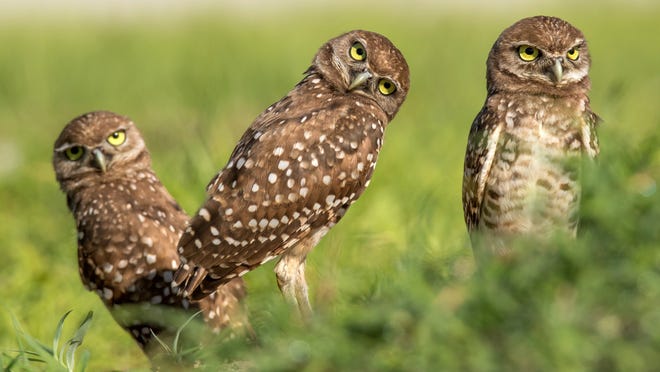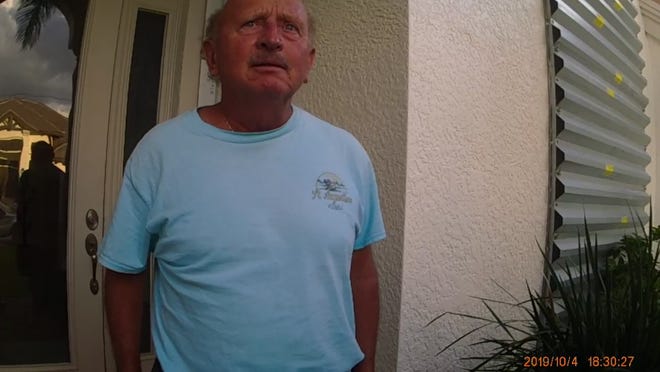Burrowing owls under attack on Marco Island but many fight to protect them
 Omar Rodríguez Ortiz
Omar Rodríguez Ortiz
On a recent October morning Robbie Taylor looked towards an owl burrow in an empty lot next to his Marco Island home and observed that its wooden perch was gone.
Taking a closer look, Taylor observed small white objects by the burrow which turned out to be mothballs, a pesticide that can be poisonous if its fumes are inhaled in large amounts.

Taylor and his wife, Tracey, took pictures of the burrow, removed the mothballs, put the perch back and called Florida Fish and Wildlife Conservation Commission (FWC).
"They are not harming us," Mrs. Taylor said about the owls. "They are not doing anything."
"This is their home too."
FWC officers arrived at the scene on Oct. 3. and took statements from Mrs. Taylor and Megan Groves, a neighbor that lives on the other side of the empty lot.
"The nest was located near a for sale sign, with the listing realtor agent’s name, Roger Fleming," according to an FWC report.
Roger M. Fleming and Jacquelyn Fleming are the owners of the empty lot on 1430 Wayne Ave., according to the Collier County Property Appraiser's website.
The officers also observed a security camera from Grove's house was pointing to the burrow but were told that it was moved after the incident in case whoever did it came back.
On the next day, Groves and Mrs. Taylor reported to FWC that somebody put additional mothballs into the burrow but this time it was caught on camera.
"In the footage, you see an individual quickly walk up to the nest and throw something into the nest," according to the report. "It was later discovered that the objects in question were again mothballs."
Mrs. Taylor, who works for a real estate company, said this time the mothballs were deeper into the burrow, making them harder to remove.
"Mrs. Taylor stated that her husband had to reach his entire arm inside the nest to retrieve all of the mothballs," according to the report.

Soon after, the officers drove to Fleming’s house on Marco Island for questioning.
“The only thing I can say clearly is that it was never my intent to harm anything," Mr. Fleming said, according to the report. "My intent was to dissuade, I guess."
"I didn’t think I did anything harmful, nor was my intent to do anything harmful.”
On Oct. 8, an FWC biologist used a snake camera or scope to penetrate the nest and see if there were any more mothballs or dead owls inside but nothing of concern was observed, according to the report.
The report also identifies Mr. Fleming as the only suspect.
The Eagle visited Fleming at his home on Nov. 19, finding him outside his property, where he declined to comment.
"I think I'm OK saying nothing," Mr. Fleming said. "My attorney won't let me."
During a hearing in front of the Marco Island code enforcement magistrate on Oct. 28, the city requested a continuance of Mr. Fleming's case, the Eagle reported.
The request was made after the Flemings asked for the continuance, according to Captain Dave Baer of the Marco Island Police Department.
In Collier County court, however, Mr. Fleming is facing charges for violating Florida's administrative code which prohibits the intentional killing or wounding of any species designated as endangered or threatened, according to court records.
The next court date is scheduled for 10 a.m., Dec. 23 with Judge Tamara L. Nicola.
Two other incidents involving collapsed owl burrows have been reported in November, according to Audubon Everglades.
On Nov. 16, a volunteer reported that the fencing surrounding a burrow at Collingswood Ave. in Marco Island had been removed.
"It looks like somebody removed the fencing and drove over it (the burrow)," said Allison Smith, manager of Audubon's Owl Watch program.
"The track was within inches of one burrow and went over a second making it collapse."
Smith said the collapsed burrow had been active during this year's nesting season which started in February and ended in July.
This season resulted in 252 nesting pairs of owls established on the island, raising as many as a thousand young owlets, the Eagle reported. That's 58 more pairs than in 2018.
In response to these incidents, Smith said volunteers will start monitoring burrows all year round and not just during season.
"We are planning on keeping a closer look on them," Smith said.
Despite all this, Smith said most people care about burrowing owls.
"It's just a handful of bad guys that don't," Smith said.
More:Marco Island requests continuance in case of realtor putting mothballs in owl burrow
And:Video shows realtor putting mothballs in Marco Island owl burrow, Audubon says
Digging new homes for burrowing owls
In the fall of 2017, the owl watchers began meeting with Marco Island residents interested in having starter burrows in their front yards.
"We dig a hole a feet deep at an angle, we pile all the sand next to it so it looks like an owl burrow and we put a wooden perch for them to stand on," Smith said.
After that it's just a matter of time before burrowing owls start moving in, according to Smith.
Smith said that of 89 starter burrows 25 percent have successfully attracted owls.
The vast majority of burrowing owls live on vacant lots but as people build new houses they may eventually run out of places to live, according to Smith.
"The island is developing pretty rapidly but in 20 years there may not be enough vacant lots," Smith said.
Smith said she expects the success rate of the starter burrows to improve as younger owl couples become more experienced.
Andy Serafin, one of the residents whose starter burrow attracted owls, said he learned of the program after seeing an advertisement in the Eagle.
"It just so happens that right at that time my brother had passed away and he was a big 'birderer' up in the Chicago area," Serafin said.
"I saw the ad and it kind of clicked with me that it would be a really cool thing to do for my brother."
Serafin said he wrote his brother's name on the perch but it faded away.
"We waited a few months and [...] one owl came and got its partner," Serafin said. "(We) waited a few more months and next thing you know we got a few eggs in the nest."
Serafin said he takes advantage of when residents and visitors stop to look at the burrowing owls to educate them on the matter and answer any questions they may have.
In some occasions, the burrowing owls can be seen from his dining room window while he eats.
"It's kind of fascinating to watch," Serafin said.
More:‘Owl in the Family’: Burrowing owls have learned to coexist with Islanders